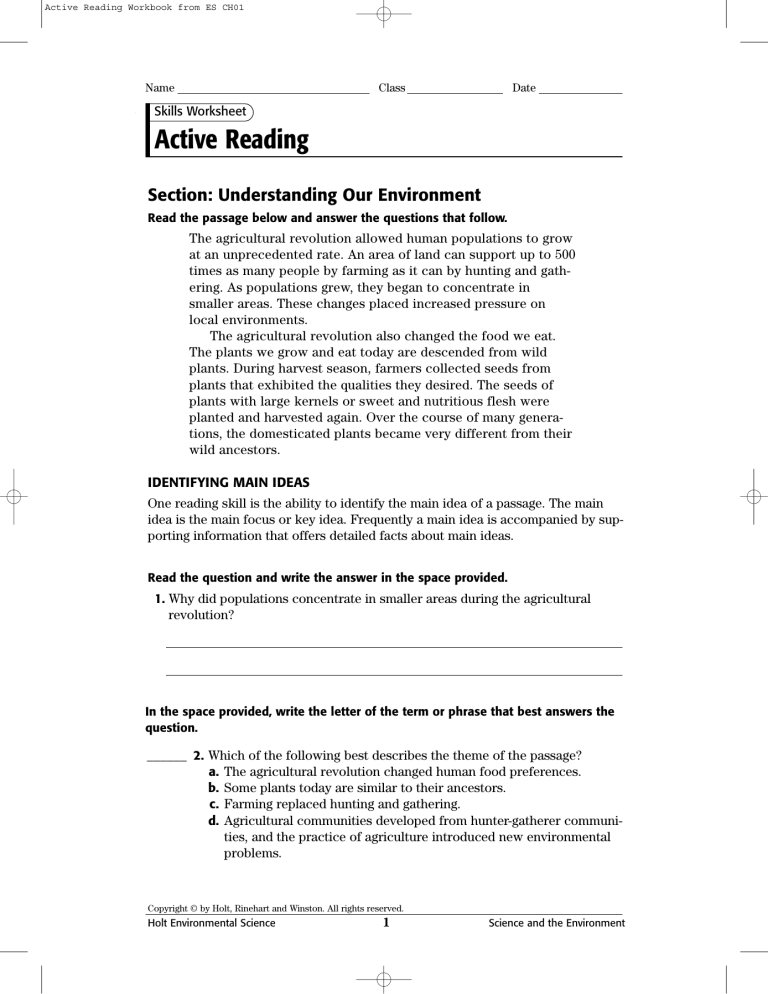Imagine standing on a windswept mountaintop, gazing across a vast expanse of emerald forests and sparkling rivers, a panorama of life teeming with vibrant colors and buzzing with energy. It’s a breathtaking spectacle, a testament to the Earth’s extraordinary beauty and the intricate dance of nature. But beneath this surface of wonder lies a web of interconnected systems, a complex tapestry woven through millions of years of evolution. This is the realm of environmental science, a field that seeks to understand the intricate interplay between living organisms and their surroundings, exploring our planet’s delicate balance and the challenges we face in safeguarding its future.

Image: studylib.net
Environmental science, at its core, is the pursuit of knowledge about our planet’s intricate workings. It’s a multidisciplinary endeavor that draws upon biology, chemistry, physics, geology, and social sciences to unravel the mysteries of ecosystems, understand the impact of human activities on the environment, and find solutions to environmental challenges. This first chapter of your environmental science journey sets the stage for exploring the fascinating world around us, a world that demands our understanding, respect, and responsible care.
A Glimpse into Environmental Science:
Stepping into environmental science is akin to entering a vast library filled with untold stories of life on Earth. It’s a journey that begins by understanding the fundamental building blocks of our planet’s diverse ecosystems. One of the first concepts we encounter is the biosphere, the thin film of life that envelops the Earth, encompassing all living organisms and their physical surroundings. The biosphere is a breathtaking tapestry, woven together by a network of interdependent relationships, from the smallest microbe to the towering redwood trees.
The Foundation of Life: Ecosystem Dynamics
Within the biosphere, we encounter ecosystems, the interconnected communities of living organisms and their physical environment. These dynamic frameworks are the heart of our planet’s ability to sustain life, each a unique story of survival, competition, and cooperation. Exploring these ecosystems reveals a fascinating interplay of elements:
- Abiotic Components: These non-living components, like sunlight, water, temperature, and soil, provide the essential foundation for life.
- Biotic Components: The living organisms within an ecosystem, from plants and animals to fungi and bacteria, interact and shape their surroundings.
Understanding these components unlocks a deeper understanding of how ecosystems function, how energy flows through them, and how they adapt to change.
The Interconnectedness of Life: Cycles and Processes
Life on Earth thrives through a series of interconnected cycles, intricate processes that govern the movement of energy and matter. Understanding these cycles is crucial for appreciating the delicate balance of our planet’s systems.
- The Water Cycle: This continuous journey of water, from evaporation to condensation and precipitation, nourishes ecosystems and sculpts landscapes.
- The Carbon Cycle: Carbon, the backbone of life, journeys through the Earth, from the atmosphere to living organisms and back again, influencing climate and shaping ecosystems.
- The Nitrogen Cycle: Nitrogen, a vital element for life, cycles through the air, soil, and living organisms, fueling the growth of plants and animals.
These cycles demonstrate the interconnectedness of life, revealing how everything is intrinsically linked, from the smallest microbe to the grandest biomes.

Image: studylib.net
The Human Impact: Navigating a Changing World
As we delve deeper into environmental science, we can’t ignore the pervasive impact of human activities on our planet. Our actions have profound consequences, often altering the delicate balance of ecosystems and driving rapid environmental change.
- Population Growth and Consumption: The increasing human population and our insatiable appetite for resources create tremendous pressure on the environment, leading to deforestation, habitat loss, and pollution.
- Pollution and Climate Change: Our reliance on fossil fuels and industrial processes has released vast quantities of greenhouse gases into the atmosphere, driving global climate change and its far-reaching consequences.
- Resource Depletion: Our relentless consumption of natural resources, especially finite resources like fossil fuels and minerals, depletes the Earth’s resources and threatens future generations.
This chapter of environmental science requires us to confront the challenges we’ve created and to recognize the responsibility we hold for ensuring a healthy planet for future generations.
Tools for Understanding and Solutions for Action
Environmental science is not just a field of study; it’s a catalyst for action, a roadmap for navigating a path towards sustainability.
- Scientific Tools: Environmental science utilizes a toolkit of scientific methods, from observation and experimentation to data analysis and modeling, to investigate environmental problems and discover solutions.
- Sustainable Practices: We can leverage our knowledge of environmental science to implement sustainable practices in all aspects of our lives, from reducing our carbon footprint and conserving water to supporting sustainable agriculture and promoting responsible waste management.
Environmental Science Chapter 1 Review
Building a Sustainable Future: Your Role in the Story
Environmental science isn’t just about reciting facts; it’s about empowering individuals to become stewards of our planet. Every choice we make, from the food we eat to the transportation we use, has an environmental impact. This chapter of your journey is about understanding that impact and making informed decisions that benefit both our planet and ourselves.
The future of our planet depends on our collective action. We must embrace the lessons of environmental science, act responsibly, and create a sustainable future for generations to come. Let’s work together to unravel the tapestry of the Earth, understanding its intricate beauty and its vulnerability, and committing to protecting it for all time.





